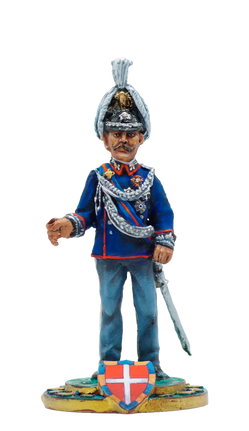
Prince Vittorio Emanuele
Count of Turin
Prince Vittorio Emanuele of Savoy-Aosta, Infante of Spain, Count of Turin (24 November 1870 – 10 October 1946) was a grandchild of King Victor Emmanuel II and a member of the House of Savoy. He was a cousin of Victor Emmanuel III. Vittorio Emanuele was born in Turin just before his father Prince Amadeo of Savoy, Duke of Aosta was about to leave for Spain where he had been elected king. His mother was Maria Vittoria del Pozzo della Cisterna. With his father's accession to the Spanish throne he gained the additional title Infante of Spain. In 1897 Vittorio Emanuele challenged Prince Henri of Orléans to a duel, after Henri described, in several articles in the newspaper Le Figaro, the Italian soldiers being held captive in Ethiopia during the First Italo–Ethiopian War as cowards. The dispute was widely echoed in Italy and Europe. It was agreed on the use of the sword as weapon of choice, as the Italians thought duels with pistols, favored by the French, were worthy of betrayed husbands, not of princes of royal blood. Vittorio Emanuele defeated Henri after five reprises. Henri received a serious wound to his right abdomen, and the doctors of both parties considered the injury serious enough to put him in a state of obvious inferiority, causing the end of the duel and making Vittorio Emanuele famous in Europe. The public response for Vittorio Emanuele in Italy was triumphant. In Turin King Umberto I welcomed him saying, "I want to be the first to congratulate you with all my heart on the example you set and the success you scored". Vittorio Emanuele pursued a career in

the Royal Italian Army and became the Commander in Chief of the Italian Cavalry. He held this position during the First World War.

The 1st Infantry Regiment "Re" (Italian: 1° Reggimento Fanteria "Re") is the oldest regiment of the Italian Army, dating back to 1624 when the Marquis Trivier de Fleury established the Regiment "Fleury" with French troops for service in the army of Charles Emmanuel I, Duke of Savoy. The regiment consisted of 15 companies with 100 men each and fought in 1628 in the War of the Mantuan Succession. The regiment served in all the wars of the Savoyard state until 1798 when it was disbanded due to Revolutionary France occupying Piedmont and forcing Charles Emmanuel IV of Sardinia to abdicate the throne in favor of the Piedmontese Republic. The regiment was reformed in early 1800 as Regiment "Savoia" to fight against the French in the War of the Second Coalition, but after the Austrian defeat on 14 June 1800 at the Battle of Marengo the regiment was disbanded again. With the defeat of Napoleon at the Battle of Leipzig and the restoration of the Kingdom of Sardinia in 1814 the regiment was reformed. In 1815 it was renamed Brigade "Savoia". On 25 October 1831 the brigade split to form the 1st Regiment and 2nd Regiment under the brigade's command. The brigade and its two regiments fought in the First Italian War of Independence and the 1st Regiment earned a Silver Medal of Military Valor for its conduct during the campaign in Lombardy. The brigade also fought in the Second Italian War of Independence, during which the 1st Regiment was awarded a Bronze Medal of Military Valor for its conduct in
the Battle of San Martino. After the Second Italian War of Independence the Second French Empire annexed Savoy on 14 June 1860 and therefore the brigade was renamed on the same day as "Brigade of the King" (Italian: Brigata del Re). In 1866 the regiment fought in the Third Italian War of Independence.

The House of Savoy (Italian: Casa Savoia) is an Italian royal house (formally a dynasty) that was established in 1003 in the historical Savoy region. Through gradual expansions the family grew in power, first ruling a small Alpine county northwest of Italy and later gaining absolute rule of the Kingdom of Sicily. During the years 1713 to 1720, they were handed the island of Sardinia and would exercise direct rule from then onward. Through its junior branch of Savoy-Carignano, the House of Savoy led the Italian unification in 1861, and ruled the Kingdom of Italy until 1946. Duke of Aosta (Italian: Duca d'Aosta; French: Duc d'Aoste) was a title in the Italian nobility. It was established in the 13th century when Frederick II, Holy Roman Emperor, made the County of Aosta a duchy. The region was part of the Savoyard state and the title was granted to various princes of the House of Savoy, second sons of the reigning king of Sardinia or king of Italy. The title was re-created in 1845 for Prince Amadeo, son of Victor Emmanuel II, and thereafter held by him and his descendants until the abolition of the Italian monarchy in 1946.

Royal Standard of the King of Italy. The king of first the Kingdom of Sardinia and then the Kingdom of Italy had his own royal banner: A blue flag with an eagle with crown and four crown at corners.
Awards: Sash and star of the Military Order of Savoy (Ordine militare di Savoia), Stars of the Supreme Order of the Most Holy Annunciation (Ordine Supremo della Santissima Annunziata), the Order of Saints Maurice and Lazarus (Ordine dei Santi Maurizio e Lazzaro) and the Order of the Crown of Italy (Ordine della Corona d'Italia).










